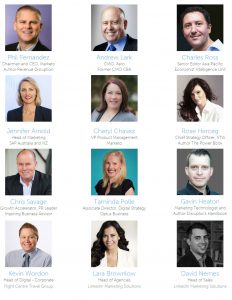We all know that innovation is good for business. We all know it’s good for our brands. And we all know it’s good for people – our employees, customers, suppliers and so on. But we also know that innovation is difficult. Problematic. And prone to failure. In fact, when visionary analyst, R “Ray” Wang looked into the data, he found that 52% of the Fortune 500 have disappeared since 2000. Such is the nature of this new form of “digital disruption” that new technologies and business models are decimating whole industries and categories. The iPhone as a single device, for example, says Ray Wang, killed 27 business models in one fell swoop.
The question that business leaders are asking is not just “WHAT is next” – but “is MY BUSINESS/INDUSTRY next”?
Time to slay the IDEAS dragon
Over the last 12 months or so I have been working to not only understand what is going on with the trends, technologies and consumer behaviours – but on methods that can help innovators from the front desk to the corner office – combat and address digital disruption. The solution requires a new approach to innovation. A rethinking of models – and even the adoption of business practices that we had thought were passe – uncool or even unnecessary.
But the very first act of the innovator is to slay the IDEAS DRAGON. It’s time we faced down the hard reality of innovation and entrepreneurship and realised that ideas are just not good enough. In fact, in pursuing ideas, we deny the true purpose of innovation – to address “problems worth solving”. The fact that many corporate (and entrepreneurial) initiatives and startups commence with an “idea” means that they are starting without the foundation of a burning platform. For entrepreneurs this means that the struggle to find product-market fit will take longer, and more difficult. And for intrapreneurs, those corporate, internal change makers, it means burning resources and opening yourself to a “career limiting” project. As David Burkus explains in this Harvard Business Review article:
When most organizations try to increase their innovation efforts, they always seem to start from the same assumption: “we need more ideas.” They’ll start talking about the need to “think outside the box” or “blue sky” thinking in order to find a few ideas that can turn into viable new products or systems. However, in most organizations, innovation isn’t hampered by a lack of ideas, but rather a lack of noticing the good ideas already there.
It’s not an idea problem; it’s a recognition problem.
Where there’s a burning platform there’s money to fix it
One thing that I have learned from my clients is that ideas have a currency – that of attention. A good, strong and catchy idea can take hold of the imagination of an entire Boardroom and ripple across an organisation. And as those waves spread, they become smaller. By the time they reach someone who is willing to take the idea on, it’s likely that the idea has lost its potency. It’s energy. It’s Board level support.
By establishing the Disruptor’s Handbook, my plan was to create a strategy and innovation firm focused on collaboratively helping work from the problem outwards. And by focusing on the “problems worth solving”, by seeking out the problems that keep C-suite executives awake at night, we realised that where there is a burning platform, there’s money to fix it. And the reason funding is available is that the product, service or experience has customers. Paying customers. And in the world of startups, that is known as product-market fit.
Think market-product fit first for success
Rather than looking for “product-market fit”, however, we should be reversing this. We need to be looking for “market-product fit”. We need to put the needs, expectations and demands of our market first. This has a range of benefits:
- Reduced risk
- Improved levels of word of mouth
- Easier customer acquisition and retention
- Early stage focus on delivering customer value over product features
With this in mind, much of our process with Disruptor’s Handbook has been designed to focus on what we call “marketing-led innovation”. And one key component of this strategy is the use of “distributed research and development”. In our eBook, Joanne Jacobs explains that taking this approach, almost any organisation can innovate like a startup:
[Distributed R&D is] … literally a mechanism where the prototyping stage of R&D is spread to an array of competing or collaborating innovators, with minimum viable products (MVPs) generated over a highly concentrated period.
And the proof is in the pudding. Partnering with Qantas on their first hackathon saw us working with senior business leaders and coders, entrepreneurs and other innovators to solve challenging and intractable problems that the airline had been struggling with. At the end of 24 hours of “distributed R&D”, teams presented 10 working demos to judges and Qantas executives. Many of these projects are now moving to commercialisation. The process is generating not just ideas but real businesses and real business value – and is doing so because:
- The process slays the ideas dragon and focuses on problems worth solving
- Problems that are “worth” solving have budgets and audiences attached
- Market-product fit means that innovators are shipping “minimum buyable products” not just products that are “viable”.
Can Distributed R&D also work for your firm? Of course it can – contact us to find out more.




